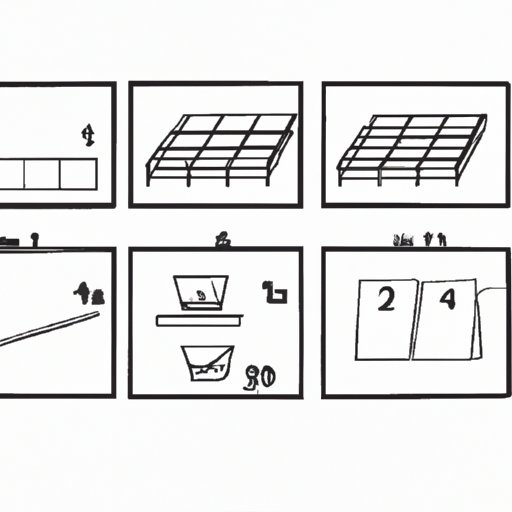Introduction
Calculating area is a crucial skill that helps us in everyday situations, from determining how much paint to buy for a room to estimating the area of a garden or a construction site. Area refers to the total space occupied by a two-dimensional shape and is measured in square units, such as square feet or square meters. In this article, we’ll explore how to calculate the area of various shapes, from simple to complex, and look at practical examples of why this skill is important.
Step-by-Step Guide on How to Calculate the Area of Simple and Complex Shapes
Calculating the area of a shape depends on the type of shape. For simple shapes such as triangles and rectangles, we can use standard formulas. For more complex shapes such as circles, trapezoids, and irregular polygons, we need to break them down into simpler shapes and sum their areas. Here are some basic formulas:
- Rectangle: Area = Length x Width
- Triangle: Area = (Base x Height) / 2
- Circle: Area = π x (Radius x Radius)
- Trapezoid: Area = ((Base 1 + Base 2) / 2) x Height
- Regular Polygon: Area = 0.5 x Perimeter x Apothem
When calculating the area, it’s crucial to use the correct units and be consistent. For example, if you’re calculating the area of a room in feet, you need to use feet for length and width measurements.
Let’s look at some examples:
Example 1: Rectangle
Suppose you’re planning to install new tiles in a rectangular kitchen measuring 10 feet by 12 feet. To calculate the area, multiply the length times the width:
Area = Length x Width
Area = 10 feet x 12 feet
Area = 120 square feet
Example 2: Circle
Suppose you want to build a circular pond with a diameter of 6 meters. To calculate the area, you need the radius, which is half the diameter:
Radius = Diameter / 2
Radius = 6 meters / 2
Radius = 3 meters
Now, use the formula for the area of a circle:
Area = π x (Radius x Radius)
Area = 3.14 x (3 meters x 3 meters)
Area = 28.26 square meters
Visual Tutorial on How to Use Graph Paper to Calculate the Area of Irregular Shapes
Irregular shapes can be more challenging to calculate, but one useful technique is to use graph paper. Graph paper is a special paper with a grid of squares that makes it easy to break down irregular shapes into smaller, regular shapes. To calculate the area of an irregular shape, follow these steps:
- Draw the shape on the graph paper and ensure that the shape fills the entire grid.
- Count the number of squares that the shape covers.
- Multiply the number of squares by the area of one square.
Here’s an example:

Count the number of squares: 16
Area of each square: 1 square inch
Total area = 16 square inches
Remember that the size of each square depends on the scale of the graph paper, so be sure to use a consistent scale when calculating the area.
Importance of Calculating Area in Real-Life Situations
Calculating area is important in many real-life situations, such as:
- Construction: builders need to calculate the area of a site to estimate materials and costs, such as concrete, steel, and roofing materials.
- Gardening: landscape designers need to calculate the area of a garden to determine how much soil, mulch, or plants are needed.
- Cooking: bakers and chefs need to calculate the area of baking dishes and other containers to estimate the amount of ingredients needed.
Incorrect calculations of area can lead to problems such as wasted resources, incorrect budgeting, and safety hazards. For example, if an area is calculated incorrectly in construction, builders might order too many materials, causing extra expenses and waste. In gardening, if the area is calculated incorrectly, the plants might not have enough space to grow properly, leading to poor yields.
It’s essential to double-check area calculations before beginning any project or making any purchases. A simple mistake in measuring the area can lead to costly errors.
Comparative Analysis of Different Methods to Calculate Area
There are different methods for calculating area, including:
- Traditional formulaic approach: using standard formulas to calculate the area of simple and complex shapes
- Online calculators: websites that allow you to enter measurements and receive calculated areas automatically
- Specialized software: such as CAD or GIS programs that have advanced features for calculating area and volumes of complex shapes
Each method has its pros and cons. For example, the formulaic approach is simple and requires no special tools, but may not be suitable for complex shapes. Online calculators are convenient but may not provide accurate results or may not be adapted to specific needs. Specialized software is more advanced but may require a learning curve and be costly.
It’s important to choose the appropriate method depending on the situation and the level of accuracy required.
Interactive Quiz or Game to Test Knowledge on Calculating Area
Now, it’s time to put your knowledge to the test! Try our interactive quiz or game to check how well you understand calculating area. Answer questions about different shapes, compare different methods, and get instant feedback. You can also challenge yourself with fun puzzles and exercises. Keep practicing to become a pro!
Conclusion
Knowing how to calculate area is a valuable skill that can help us in many different areas of our lives, from home improvement to professional projects. By following our step-by-step guide for simple and complex shapes, and by learning how to use graph paper for irregular shapes, you can become more confident in your area calculations. Remember that accuracy is crucial, especially in real-life situations.
